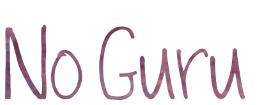body type
Submitted by lindsay on Tue, 03/18/2014 - 15:34
The tactile nature of your skin and hair make up the overall texture of your appearance. If your skin is clear of natural markings, and your hair sleek, you have a satin and shiny texture. On the other hand, if your skin is freckled, and your hair is naturally wavy, you have a suede and matte texture. But as we age or as we style ourselves, changes in our texture are bound to happen. When you match up the texture of your fabrics to your own texture, you are flattering your natural appearance.
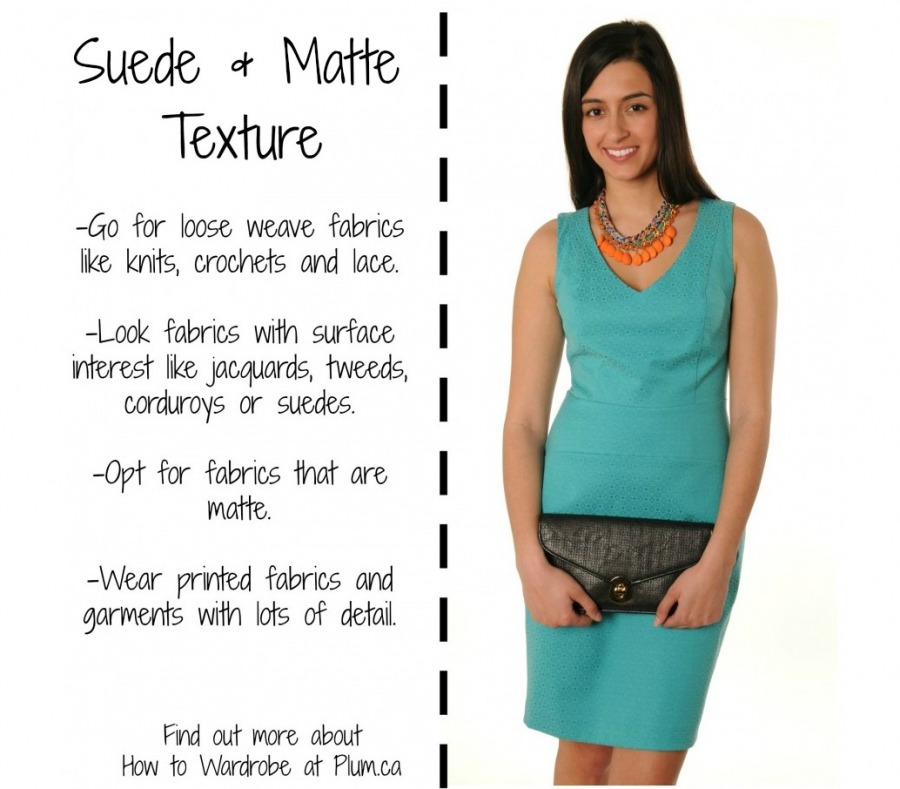
If you have a suede and matte texture, wear fabrics with surface interest like a jacquard. When compared to a smooth fabric, the jacquard harmonizes with your natural texture so that any wrinkles or freckles on your skin aren’t as prominent. On the other hand, if you regularly flat-iron your hair, your texture becomes more balanced. You could wear a textured fabric to better effect by choosing a solid coloured garment rather than a print.
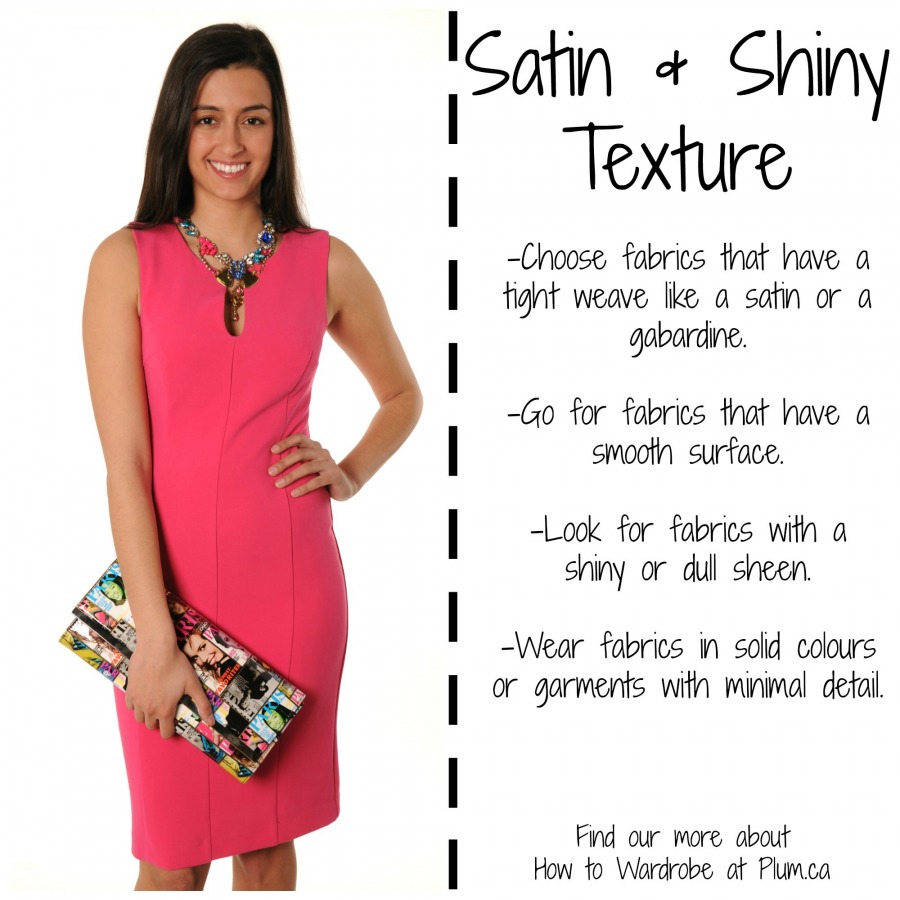
If you have satin and shiny texture to your skin, wear some fabrics with sheen to balance. Sheen attracts light which can draw attention so you would want to be aware that the style is flattering for you. On the other hand, if you can’t resist those shiny fabrics but you have a suede and matte texture, go for one with a print. The print would detract from the reflective qualities of the fabric and match your skin’s patterning, even if the fabric was smooth to the touch.
Play with textures to see where you fit at this time of your life, and notice how the different fabrics make you look. By knowing how fabrics affect your texture, you’ll be able dress for a better effect.
Find out more about the rules of texture and How to Wardrobe at plum.ca.
 ... read the full post and reader comments ... read the full post and reader comments
Submitted by lindsay on Tue, 03/11/2014 - 14:54
From traditional plaids to more painterly prints, our options are limitless nowadays when it comes to our clothing’s patterns. If you love a print, but can’t quite get it to work for your body, it might be a matter of scale.
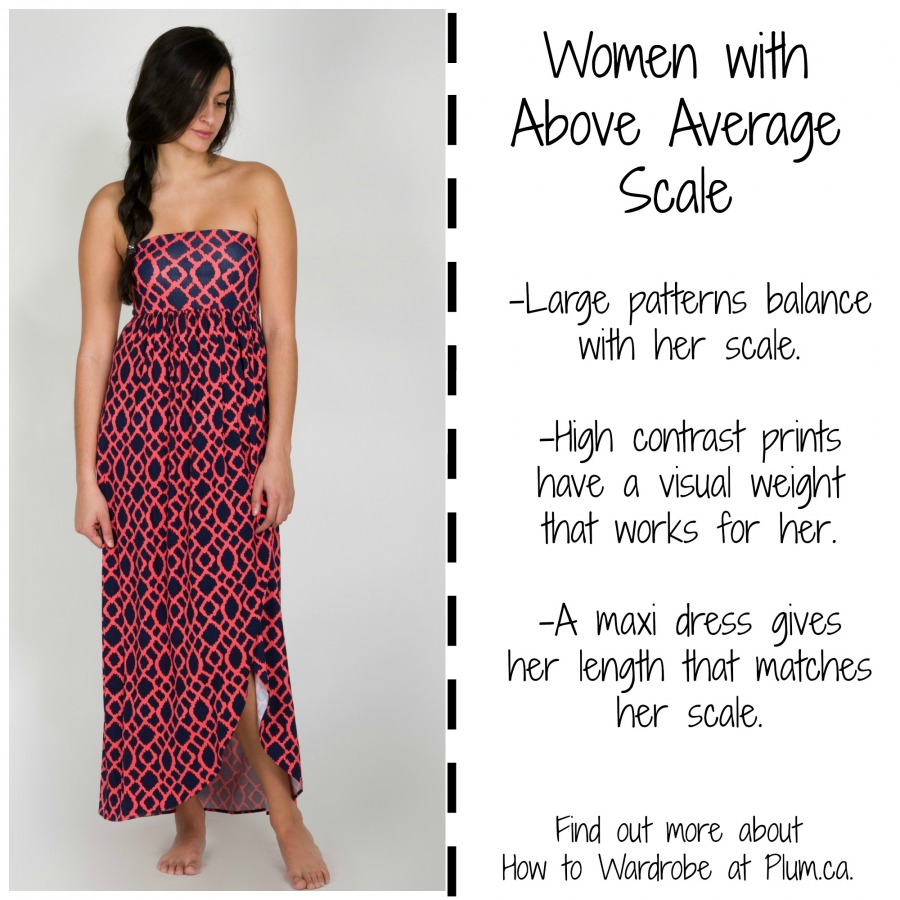
If you are above average in scale, a large repeating pattern balances with your body, whereas a small pattern would only emphasize your height. However, bold patterns with a high level of contrast (like the one shown above) have a visual weight that your frame can also handle. Because visual weight is the ability for the pattern to draw attention, you could pull off a smaller print if it had a graphic quality to it, especially if the other design features of the garment matched your scale.
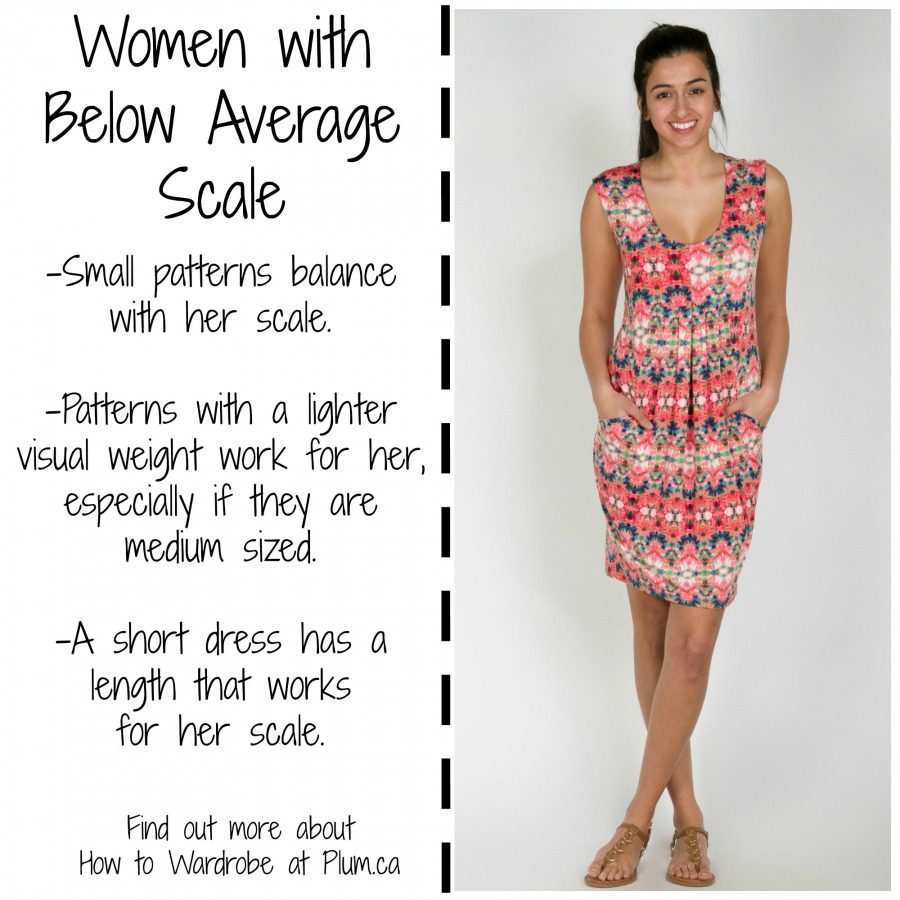
A small print can create the illusion of height if you are a petite woman, because it takes more of the pattern to cover your body. A large print, on the other hand, would overpower your frame. If you wanted to go for a bigger print, you could pull one off more easily if it had a blended pattern (as shown above). Because it’s hard to differentiate where the print begins and ends, the print has less visual weight so it can work for you, particularly if the garment`s design is suited to your scale.
When trying a new print, ask yourself: Do I stand out more than this print? Or am I being swallowed up by it? By noticing how different prints affect your appearance, you’ll know more easily which ones flatter your body’s scale.
Find out more about the Rules of Scale and how to wardrobe at plum.ca.
 ... read the full post and reader comments ... read the full post and reader comments
Submitted by lindsay on Tue, 03/04/2014 - 16:14
The lines we choose in our clothes affect our appearance--we can either harmonize them with our features or contrast them to emphasize or detract from our natural shape. Unless you want to cancel your curves, the key to line is to know that curved lines emphasize the curves you naturally possess.
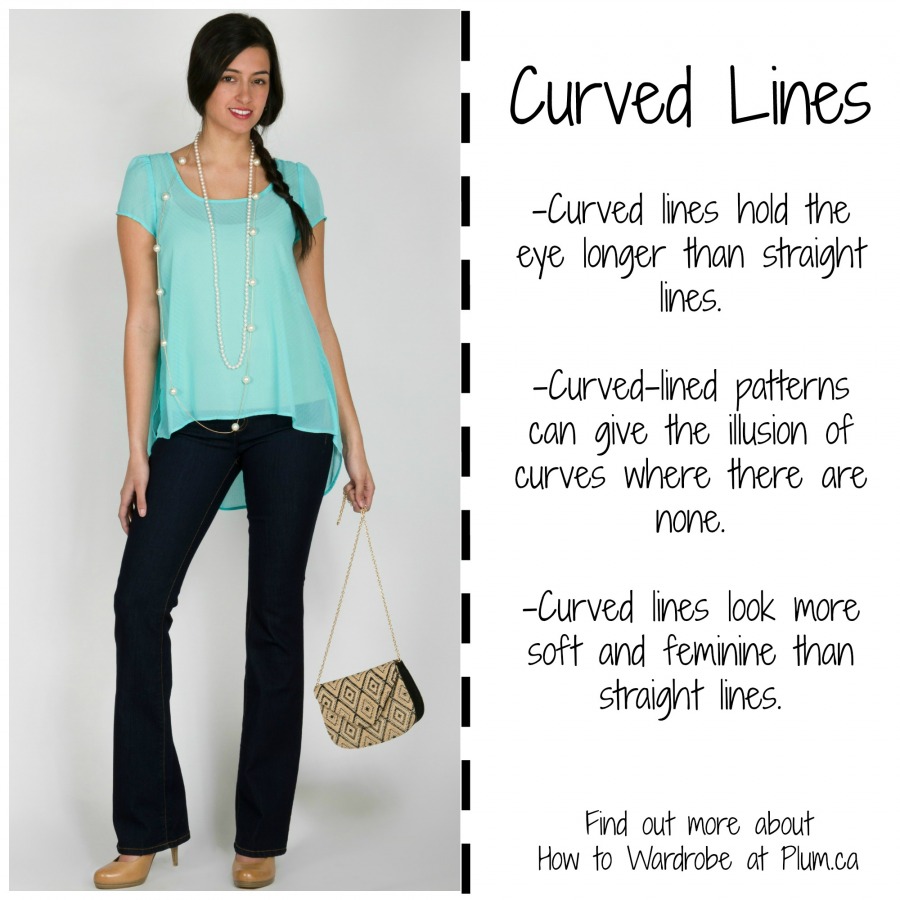
Because they create a soft drape, curved lines emphasize the roundedness of the body. For this reason, you can create curves where you might be lacking with the garments you choose. If you have narrow hips, for instance, go for a skirt with a curvy pattern and a flowing fabric to create the illusion that you’ve got shape there. Or, if you want to create harmony, choose a curvilinear blouse with a rounded neckline (as shown above) to mimic the arc of your facial features. The eye will be drawn towards your face.
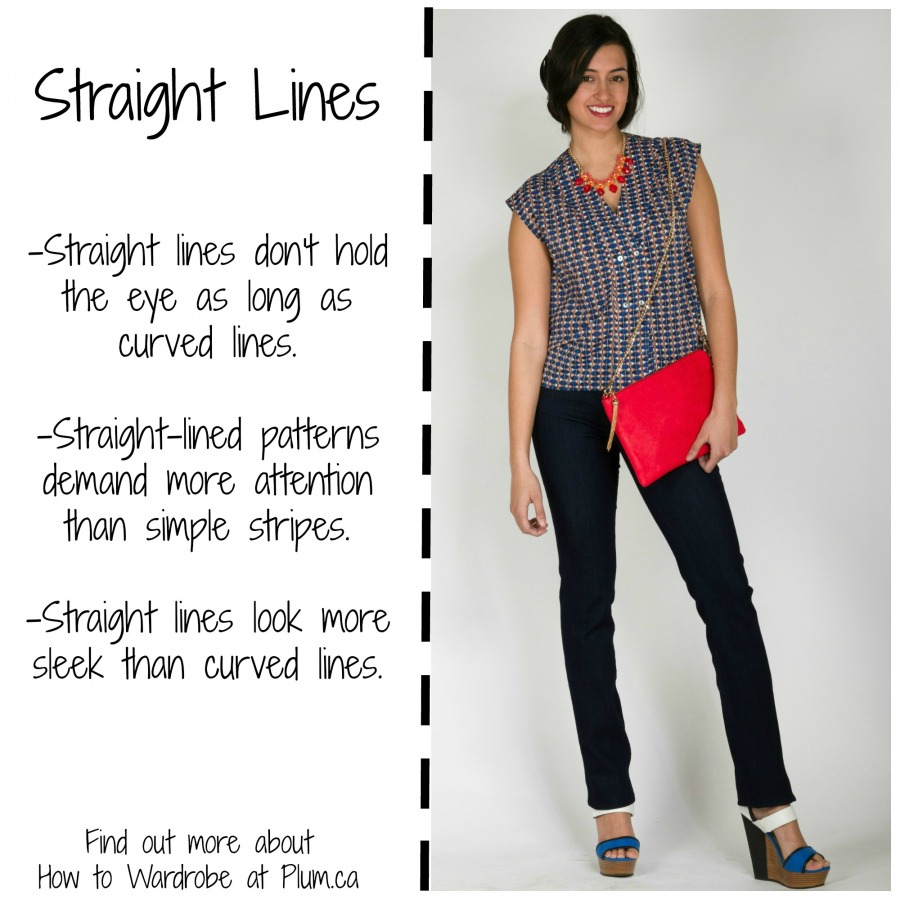
Clothes look sleeker when they are made up of straight lines as they don’t hold the gaze as long. Straight lines cut the visual space in the direction that the lines are positioned. That’s why a top with bold horizontal lines creates width at the bust, and vertical-lined jeans create length in the leg, so place these straight lines with care on the body. Because rectilinear patterns can hold attention longer than stripes, a geometric print blouse (as shown above) can create harmony with your straight-lined facial features while still maintaining the attention on you.
Read more about the Rules of Line and How to Wardrobe at plum.ca

... read the full post and reader comments
Submitted by lindsay on Tue, 02/25/2014 - 12:57
Belts and necklaces are wonder accessories. Not only do they tailor, polish, accent an outfit, but they also create focal points to draw the eye. Using them skillfully can help highlight and balance your proportions.
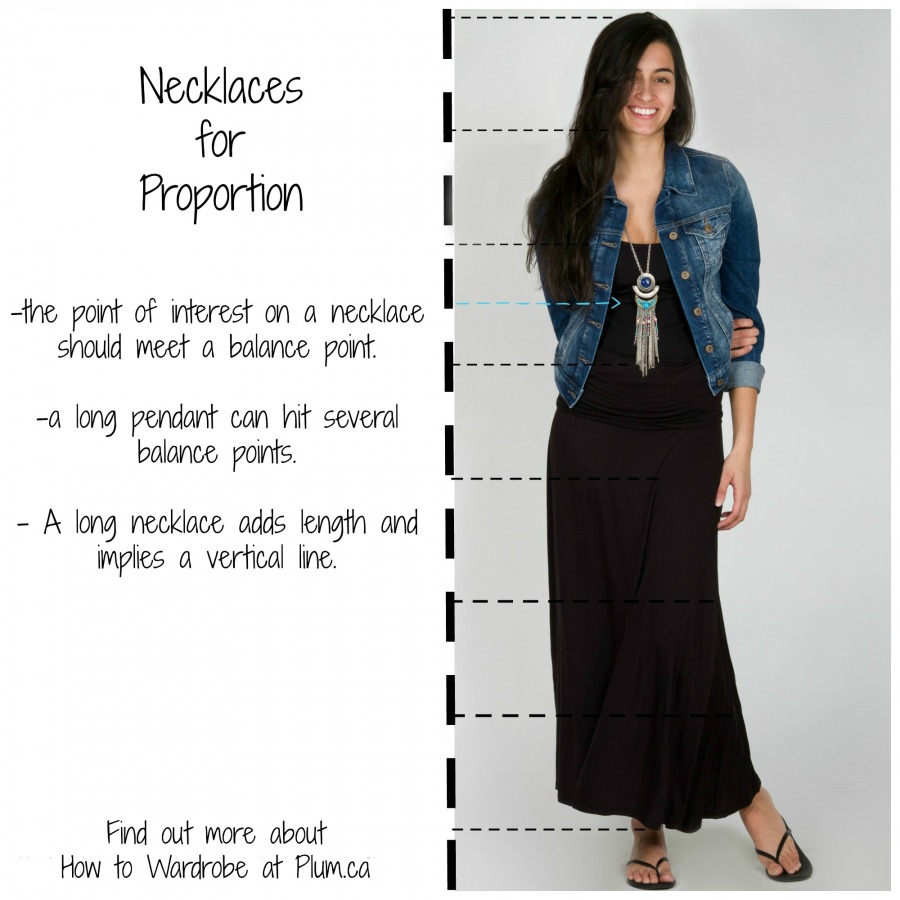
When you are adding these finishing touches to your look, adjust a long necklace so that the point of interest meets a balance point. Not only will someone’s eye be drawn to the details, but it will also imply a vertical line on your torso and create length. On the other hand, a short necklace will keep the eye around the neckline.
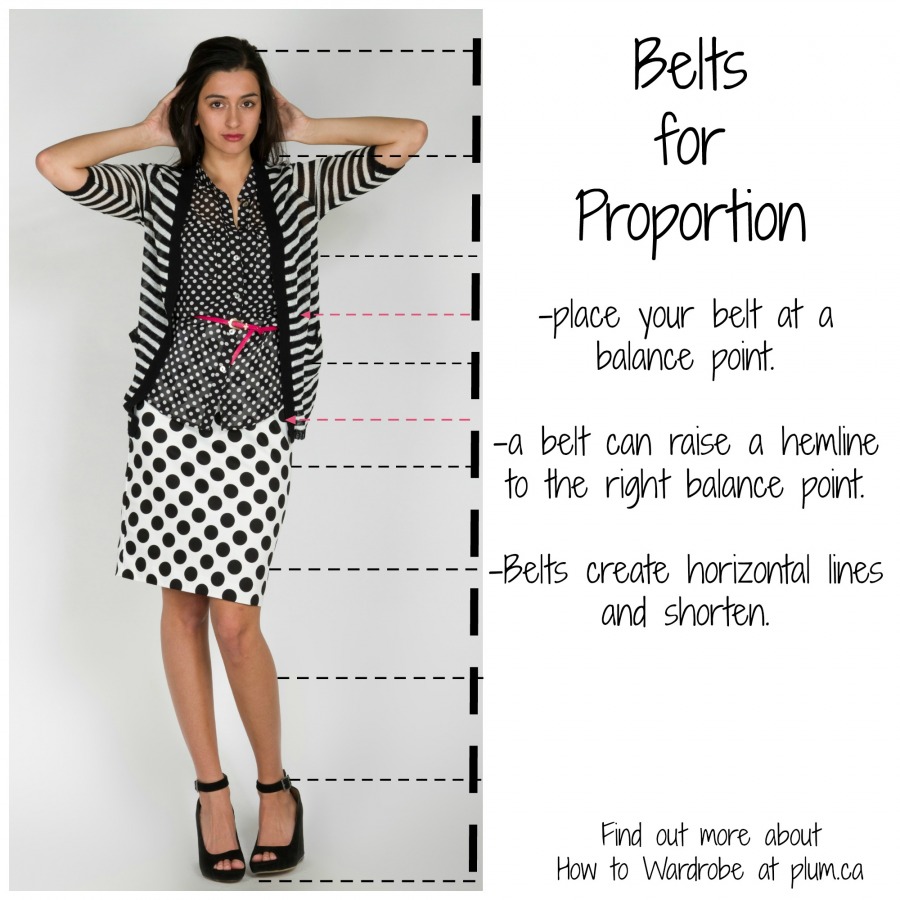
Place a belt where it makes more sense for your proportions. For instance, if you have a long waist with shorter legs, you may want to create balance by wearing your belt at the balance point closest to your natural waistline. The belt creates a horizontal line dividing your body in two, and placing a belt higher on your body will elongate your bottom half to create more balance. If you have a short torso, wear your belt so that it meets a balance point further down on your hip.
By understanding your body’s proportions, you can effectively create focal points where your proportions will balance. In the end, your outfit will look more harmonious.
Read more about the Rule of Proportion and How to Wardrobe on plum.ca.

PS: Due to snow, we have extended our West 4th Warehouse Sale until Sunday, March 2nd!
... read the full post and reader comments
Submitted by lindsay on Fri, 10/11/2013 - 09:43
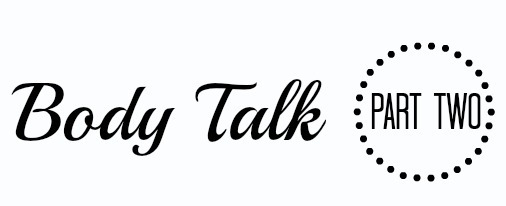

You might be wondering how exactly the elements of design in your body match elements of design in your clothes to create harmony. After our last post, you may have been inspired to take a good look in the mirror to see just what your elements of design might be! Not only that, but we hope you’ll take a look in your closet too and make a note of how the pieces you love reflect the elements of design that exist in your body. You might also notice that pieces that don’t work just don’t match who you are, which makes it easier to let things go!
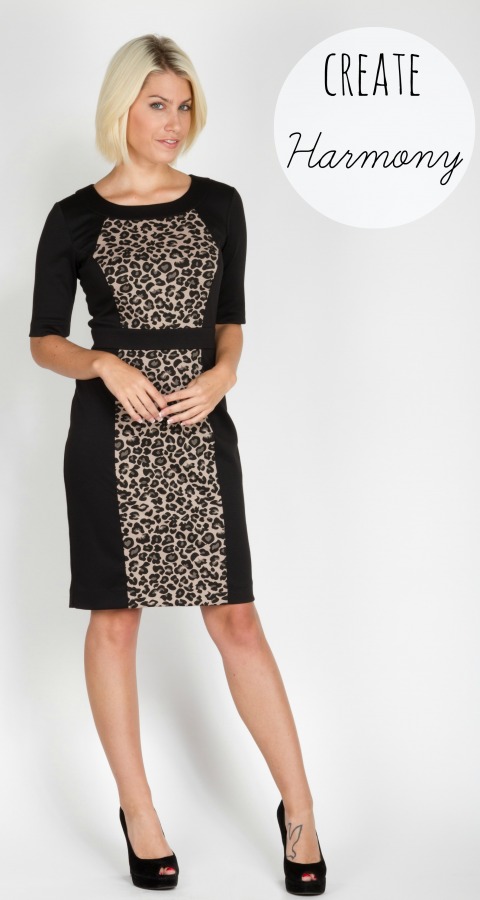
Here are some good guidelines to help you out, keeping in mind that this is general advice and your personality and lifestyle still need to be taken into account (more on that later!):
-
Scale – are you tall or short or somewhere in between? If you’re tall, that’s awesome, you get to wear long coats, jackets and cardigans, big jewellery and lots of volume in your clothes. If you’re short, that’s equally awesome – you get to wear short hemlines, narrow clothes and smaller details.
-
Proportion – are you evenly divided into eight lengths along your body and do things sit where they’re supposed to? An easy way to remember this is the ‘8 Heads Rule’. The length of your head from the top to the chin is roughly 1/8 of your height. If you’ve got a neckline, waistline or hem that isn’t working, it might be too high or too low. Things sit best right at the lines of division, or exactly at the halfway point. If they sit a little bit higher or lower, they can look a little odd.
-
Line – so you have curvy or straight lines, but what does that mean in your clothes? If you have curvy lines, you will likely feel more comfortable in things that have wrapping, ruching, princess (curved) seams, curved lapels and things with softness. If you’ve got straighter lines, you might like things that are more tailored, with pointed collars, straight lines in patterns or sharply creased pants.
-
Shape – the shape of you determines the shape of your clothing too! If you are a bit of a rectangular shape (like me, my bust and hips and waist are all roughly the same size), then you’ll do well in clothes that are more rectangular, like shift dresses (which I wore all summer), tunics, flat front pants and jackets that fit close to your body but don’t nip in at the waist. If you’re smaller at the waist, then you might like things that have detail at the waist. If your face shape is oval, you’ll likely feel more comfortable in oval shaped earrings and necklaces rather than square or rectangle shapes.
-
Texture – you can find texture either in the construction of the fabric, such as tweed or corduroy, or in the visual, with a pattern. If you’re more textured (remember, curly or wavy hair, freckles or lovely lines), look for things that have a bit of texture. If you’re smoother (straight sleek hair, more angular shape), then look for smooth fabrics such as tightly woven wool/silk or some synthetics in solid colours.
We hope these few tidbits will help you let go of some of the things you haven’t been wearing and make room for choices that are more purposeful. If you need more information, we’re learning rapidly (actually, we knew a lot already and we’re rapidly integrating the new information) and are here to help!
 
Did you miss part one? Catch up on your reading here! ... read the full post and reader comments

|
 ... read the full post and reader comments
... read the full post and reader comments